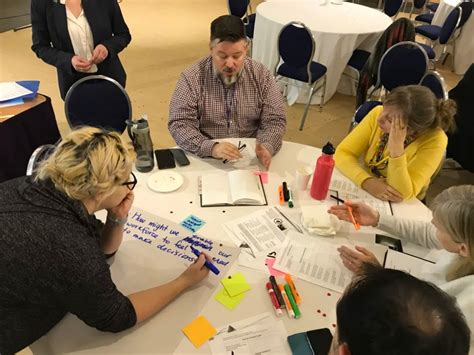Understanding the Basics of Design Thinking
Design thinking is a problem-solving approach that has gained significant popularity in recent years. It is a methodology that focuses on understanding the needs and desires of the end users to develop innovative and user-centric solutions. In this blog post, we will explore the basics of design thinking and how it can be effectively applied to various challenges.
Design thinking involves a human-centered approach, where designers empathize with the users to gain a deep understanding of their wants, needs, and expectations. This phase is called the empathy phase, where designers put themselves in the shoes of the users to gather insights and develop a sense of empathy towards them. By doing so, designers can uncover underlying pain points and design opportunities.
The next phase in the design thinking process is the define phase. In this phase, designers analyze the information gathered in the empathy phase and identify the core problems that need to be solved. This involves synthesizing the data, identifying patterns, and framing a problem statement that clearly defines the challenge at hand. The problem statement should be specific, actionable, and focused on the user’s needs and goals.
Once the problem has been defined, designers move on to the ideation phase. This is where creativity comes into play. Designers brainstorm and generate a wide range of ideas and concepts to solve the defined problem. The focus here is on quantity, not quality. The aim is to come up with as many ideas as possible without any judgment or criticism. From these ideas, designers can then select the most promising ones to move forward with.
Design thinking also emphasizes the importance of prototyping and testing. In the prototyping phase, designers create low-fidelity prototypes to bring their ideas to life. These prototypes can be simple sketches, paper prototypes, or digital mock-ups. The goal is to quickly visualize the concepts and gather feedback from users to refine and improve the solutions. Through testing and iteration, designers can refine their designs and ensure that they meet the users’ needs effectively.
In summary, design thinking is a powerful problem-solving methodology that puts the user at the center of the design process. By understanding the basics of design thinking and following its iterative and user-centric approach, designers can create innovative solutions that truly meet the needs and desires of the end users.
Setting Clear Goals for the Workshop
When conducting a workshop, it is crucial to set clear goals in order to ensure a successful and productive session. By establishing specific objectives, participants can have a clear understanding of what is expected from them and can work towards achieving those goals throughout the duration of the workshop.
One of the first steps in setting clear goals for a workshop is to determine the purpose of the session. What do you hope to achieve through this workshop? Is it to educate participants on a specific topic, brainstorm new ideas, or develop specific skills? Defining the purpose will help guide the rest of the goal-setting process.
Next, it is important to break down the overall purpose of the workshop into smaller, measurable goals. These goals should be specific, attainable, relevant, and time-bound (SMART goals). For example, if the purpose of the workshop is to brainstorm new marketing strategies, a specific goal could be to generate at least 10 innovative ideas within the first hour of the session.
Once the goals are established, it is important to communicate them clearly to the participants. This can be done at the beginning of the workshop through an introduction or agenda. By sharing the goals openly, participants can align their efforts and contributions towards achieving those objectives. It also helps to provide context and motivation for their participation in the workshop.
Additionally, it can be helpful to create a visual representation of the goals using tables or lists. This can serve as a reference point throughout the workshop and help participants stay focused on the desired outcomes. Using HTML tags, such as <table> and <ul>, allow us to structure and present the goals in an organized and visually appealing manner.
In conclusion, setting clear goals for a workshop is essential for its success. By determining the purpose, breaking it down into measurable goals, and communicating them effectively, participants can have a clear direction and work together towards achieving those objectives. Visual representations in the form of tables and lists can also aid in keeping everyone focused and on track throughout the workshop.
Creating an Engaging and Collaborative Environment
The success of a workshop greatly depends on the environment in which it is conducted. Creating an engaging and collaborative environment is essential in order to foster creativity and productivity among the participants. In this blog post, we will explore some key strategies to create a conducive atmosphere for your workshop.
The first step in creating an engaging and collaborative environment is to establish clear expectations and objectives. By clearly communicating the purpose of the workshop and what you hope to achieve, you can help participants understand their roles and responsibilities. This will enable them to actively contribute to the workshop and work towards common goals.
Another important aspect of creating an engaging and collaborative environment is to provide a comfortable physical space. Ensure that the workshop venue is spacious enough to accommodate all participants comfortably. Arrange the seating in a way that encourages interaction and collaboration. Consider using round tables or small group setups to facilitate discussions and teamwork.
Furthermore, incorporating interactive activities and icebreakers can help create a positive and engaging atmosphere. Use fun and energizing activities to break the ice and create a sense of camaraderie among the participants. This will help them feel more relaxed and open to sharing their ideas and opinions.
In addition to the physical space and activities, it is crucial to encourage active participation and inclusivity. Create opportunities for everyone to contribute and be heard. Encourage participants to share their thoughts, ask questions, and challenge assumptions. Emphasize the value of different perspectives and ensure that everyone feels respected and included in the decision-making process.
Lastly, make effective use of technology and tools to enhance collaboration. Utilize online collaboration platforms or project management tools to facilitate communication and document sharing. This will enable participants to work together seamlessly, irrespective of their physical location. Additionally, consider using visual aids such as charts, graphs, or interactive presentations to make the content more engaging and comprehensible.
- Establish clear expectations and objectives
- Provide a comfortable physical space
- Incorporate interactive activities and icebreakers
- Encourage active participation and inclusivity
- Make effective use of technology and tools
| Key Strategies: | Description: |
|---|---|
| Establish clear expectations and objectives | Communicate the purpose and goals of the workshop to create a shared understanding among participants |
| Provide a comfortable physical space | Select a spacious venue and arrange seating in a way that encourages interaction and collaboration |
| Incorporate interactive activities and icebreakers | Use energizing activities to break the ice and create a sense of camaraderie among participants |
| Encourage active participation and inclusivity | Create opportunities for everyone to contribute, ask questions, and challenge assumptions |
| Make effective use of technology and tools | Utilize online collaboration platforms and visual aids to enhance communication and collaboration |
Selecting the Right Tools and Activities
When it comes to the design thinking process, selecting the right tools and activities is of utmost importance. The tools and activities you choose will greatly impact the outcome of your design workshop and the effectiveness of your team’s collaboration. In this blog post, we will explore the factors to consider when selecting the right tools and activities for your design thinking workshop.
The first step in selecting the right tools and activities is to understand the goals of your design workshop. Identifying the specific objectives will help you determine which tools and activities are most suitable. Are you trying to generate new ideas? Improve existing products or services? Solve a specific problem? By clearly defining your goals, you can focus on selecting tools and activities that align with your objectives.
Next, consider the characteristics and preferences of your team members. Take into account their knowledge, skills, and backgrounds. Some tools and activities may be more suitable for individuals with a design background, while others may be more inclusive and suitable for a diverse team with varying levels of design expertise. By understanding your team’s strengths and weaknesses, you can select tools and activities that will promote collaboration and maximize participation.
Finally, consider the constraints and limitations of your workshop setting. Will you have access to a physical space conducive to hands-on activities? Will you have access to specific technology or materials? Ensure that the tools and activities you choose can be easily implemented within the given constraints. Additionally, consider the time available for the workshop. Some tools and activities may require a significant time investment, while others may be more time-efficient. Choose tools and activities that can be effectively executed within the allocated time frame.
- Brainstorming sessions
- Prototyping tools
- Creative thinking exercises
- User research methods
- Storytelling techniques
| Tool/Activity | Description |
|---|---|
| Brainstorming sessions | A group activity where participants generate ideas and solutions in a collaborative and non-judgmental environment. |
| Prototyping tools | Tools or software that allows participants to create mock-ups or prototypes of their ideas, helping to visualize and refine concepts. |
| Creative thinking exercises | Structured activities designed to stimulate creative thinking, such as random word associations or mind mapping. |
| User research methods | Techniques for gathering insights and understanding user needs and behaviors, such as conducting interviews or observations. |
| Storytelling techniques | Using storytelling to communicate ideas, create user personas, or envision future scenarios. |
Use this list of tools and activities as a starting point, and feel free to customize and adapt them to suit the specific needs of your design workshop. Remember that the selection of tools and activities should be driven by your goals, the characteristics of your team, and the constraints of your workshop setting. By selecting the right tools and activities, you can create an engaging and productive environment that fosters collaboration and creativity, ultimately leading to innovative solutions.
Fostering Effective Communication and Collaboration
The success of any project depends on effective communication and collaboration among team members. In the context of design thinking, fostering a culture of open and productive communication is crucial for generating innovative ideas and finding solutions to complex problems.
One way to promote effective communication and collaboration is by creating a safe and non-judgmental environment. When team members feel comfortable expressing their thoughts and ideas without fear of criticism, it encourages open dialogue and brainstorming sessions. Encourage everyone to speak up and actively listen to one another, respecting different perspectives and viewpoints.
Another important aspect of effective communication and collaboration in design thinking is the use of visual tools and activities. Visual aids such as sketches, diagrams, and prototypes can help team members better understand and articulate their ideas. Encourage the use of these visual tools during brainstorming sessions and discussions, as they can enhance clarity and engagement.
- Active Listening: Actively listen to others, giving them your full attention and showing genuine interest in their ideas. This not only encourages effective communication but also fosters a sense of belonging and respect within the team.
- Open Dialogue: Promote an environment where everyone feels comfortable speaking up and sharing their thoughts. Encourage constructive criticism and feedback, as it helps improve and refine ideas.
- Collaborative Tools: Utilize collaborative tools and software to enhance team collaboration. These tools can include project management platforms, online whiteboards, and shared document repositories.
Table:
| Benefits of Effective Communication and Collaboration in Design Thinking |
|---|
| 1. Enhanced idea generation and problem-solving capabilities |
| 2. Improved teamwork and synergy among team members |
| 3. Increased engagement and motivation |
| 4. Reduced misunderstandings and conflicts |
| 5. Faster decision-making process |
Facilitating the Design Thinking Process Step by Step
Design thinking is a creative problem-solving approach that focuses on the needs and wants of users. It is a human-centered process that enables individuals and teams to think outside the box and come up with innovative solutions. Facilitating the design thinking process requires careful planning and execution to ensure a smooth and productive workshop. In this blog post, we will walk you through the step-by-step process of facilitating the design thinking process.
Step 1: Define the Challenge – The first step in facilitating the design thinking process is to clearly define the challenge or problem at hand. The challenge should be framed in a way that encourages creative thinking and solution-focused mindset. This step is crucial as it sets the foundation for the entire workshop.
Step 2: Research and Empathize – Once the challenge is defined, it is important to conduct thorough research and empathize with the end-users or customers. This step involves gathering insights, conducting interviews, and observing user behaviors. By understanding the needs and wants of the users, facilitators can guide the participants towards creating solutions that truly address their pain points.
Step 3: Ideate and Brainstorm – The next step is to encourage participants to generate as many ideas as possible. This can be done through brainstorming sessions, idea mapping, or using design thinking tools such as “How Might We” questions. The key here is to create a safe and non-judgmental environment where everyone feels comfortable sharing their ideas.
Step 4: Create Prototypes – Once the ideas are generated, the participants should be guided to create prototypes or mock-ups of their solutions. This step allows them to visualize their ideas and get a better understanding of how the solution might work in practice. Prototypes can range from simple sketches to interactive models, depending on the resources available.
Step 5: Test and Iterate – Finally, the prototypes should be tested and evaluated. This step involves gathering feedback from users and stakeholders and incorporating their insights into the design. The goal is to continuously refine and improve the solutions based on real-world feedback. This iterative process ensures that the final solution addresses the users’ needs and is well-aligned with the initial challenge.
In conclusion, facilitating the design thinking process requires careful planning and execution. By following the step-by-step approach outlined in this blog post, facilitators can guide participants towards creating innovative solutions that truly address the needs of the end-users. So, embrace design thinking and empower your team to think creatively and solve complex problems!
Evaluating and Iterating for Continuous Improvement
Evaluating and iterating for continuous improvement is a crucial step in the design thinking process. It allows teams to assess the effectiveness of their solutions and make necessary adjustments based on user feedback. By continuously evaluating and iterating, organizations can ensure that their products or services meet the needs and desires of their target audience.
One way to evaluate the success of a design thinking project is by gathering user feedback. This can be done through surveys, interviews, or usability tests. By directly engaging with users, teams can gain valuable insights into how well their solutions are meeting user needs. It’s important to ask open-ended questions that encourage users to provide detailed and honest feedback. Analyzing this feedback can help identify any areas for improvement or potential design flaws.
Another method for evaluating and iterating is through the use of analytics. Analytics provide quantitative data about user behavior, such as how users are navigating through a website or how long they are spending on a particular page. By analyzing this data, teams can identify any usability issues or bottlenecks that may be hindering user experience. This data-driven approach allows for data-backed decision-making and can inform the iteration process.
Once feedback and analytics have been collected, it’s time to iterate on the design. This involves making changes or adjustments based on the insights gained from both user feedback and analytics. Iteration can take many forms, from making small tweaks to completely redesigning certain aspects of a solution. The goal is to continuously improve the design and address any identified issues or pain points.
In order to ensure effective iteration, it’s important to establish a culture of continuous improvement within the organization. This means fostering an environment where experimentation and learning from failures is encouraged. It’s essential for teams to embrace a growth mindset and view iteration as a natural part of the design process. By embracing the mindset of continuous improvement, organizations can stay ahead of the curve and deliver innovative solutions that truly meet user needs.
In conclusion, evaluating and iterating for continuous improvement is a vital step in the design thinking process. By gathering user feedback, analyzing analytics, and making necessary adjustments, teams can ensure that their solutions are effective and meet user needs. Embracing a culture of continuous improvement allows organizations to stay agile and deliver innovative solutions that drive success.
Frequently Asked Questions
Q: What is the basic concept behind Design Thinking?
A: Design Thinking is a problem-solving approach that focuses on understanding users’ needs, generating creative solutions, and testing and iterating on those solutions. It involves empathy, collaboration, and a human-centered design process.
Q: How do I set clear goals for a Design Thinking workshop?
A: To set clear goals for a Design Thinking workshop, it is important to define the problem or challenge you want to address, identify what you hope to achieve, and establish specific, measurable objectives. This will help guide the workshop activities and ensure everyone is working towards a common purpose.
Q: How can I create an engaging and collaborative environment during a Design Thinking workshop?
A: To foster an engaging and collaborative environment, create a space that encourages creativity and open communication. Use visual aids, collaborative tools, and icebreaker activities to promote active participation and teamwork. Encourage diversity of thought and create a safe space for sharing ideas and feedback.
Q: What are some important tools and activities to utilize during a Design Thinking workshop?
A: Design Thinking workshops can benefit from tools such as personas, customer journey maps, brainstorming techniques, prototyping materials, and feedback mechanisms. Activities like the empathy map, ideation sessions, and rapid prototyping can help generate innovative ideas and facilitate the design process.
Q: How can I foster effective communication and collaboration during a Design Thinking workshop?
A: Encourage active listening and open dialogue among participants. Use collaborative tools and techniques that promote equal participation and ensure everyone’s ideas and perspectives are heard. Foster a culture of trust and respect, and provide opportunities for constructive feedback and reflection.
Q: What steps should I follow to facilitate the Design Thinking process effectively?
A: Facilitating the Design Thinking process involves steps like understanding the problem, conducting user research, defining the problem, ideating potential solutions, prototyping and testing those solutions, and iterating based on feedback. It is important to guide participants through each step, encourage creative thinking, and provide guidance and support as needed.
Q: How do I evaluate and iterate for continuous improvement in Design Thinking?
A: Continuous improvement in Design Thinking involves evaluating the outcomes and impact of your solutions, gathering feedback from users and stakeholders, and using that feedback to make iterative improvements. Regularly review the outcomes and reflect on the challenges and successes to inform future design decisions and enhance the overall design process.





